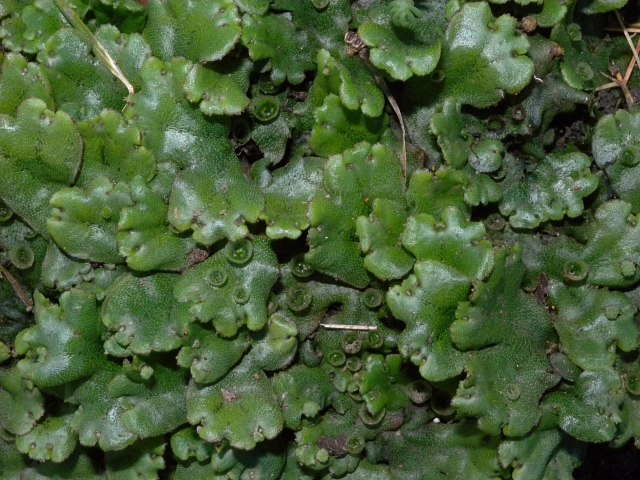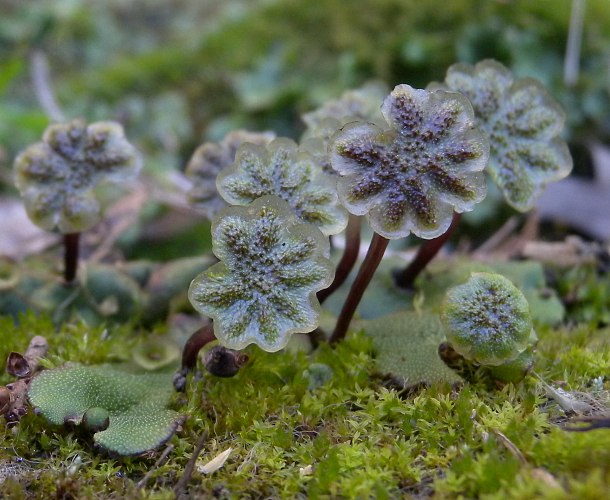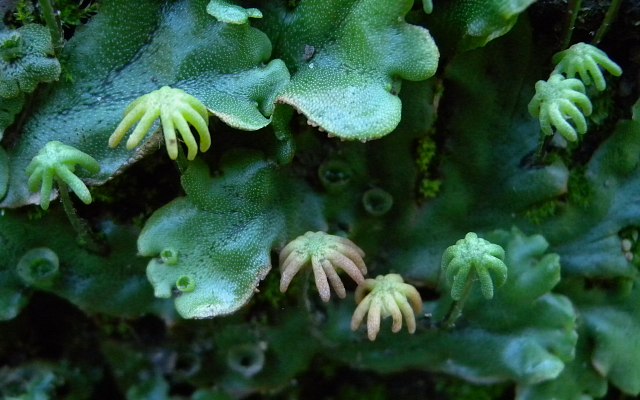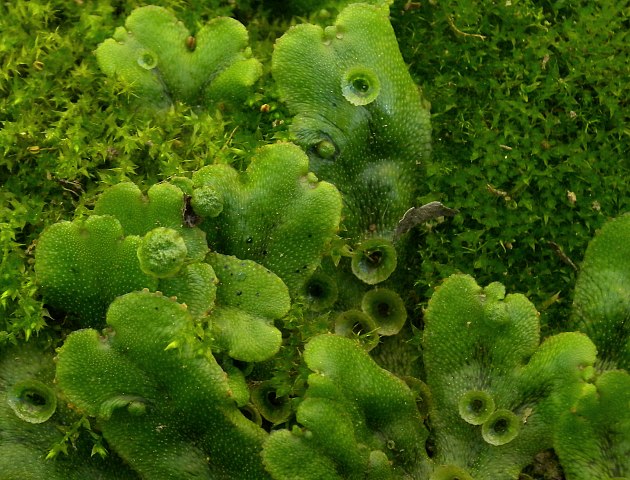
At intervals along the middle of each lobe on the upper surface the thallus, there are solitary gemma cups. These gemma cups have circular membranous rims that are crenate along their upper margins; each gemma cup is shaped like a shallow circular pan. A few gemmae (asexual plant buds) develop within each cup. Individual gemmae are about 1 mm. across, green, and more or less ovoid in shape. At maturity, they are distributed to new locations by raindrop logistics or the movement of water. After leaving the mother plant, each gemma can form 1-2 clonal plants after establishing contact with moist ground. This liverwort is dioecious, forming male reproductive organs and female reproductive organs on separate plants. On mature male plants, antheridiophores (stalked receptacles with male reproductive organs) develop from the thallus lobes; they are 1-3 cm. tall. These antheridiophores resemble flattened umbrellas in overall form, consisting of 6-8 spore-bearing lobes that radiate outward from the apex of a naked stalk. The spore-bearing lobes are elliptic-oblong in shape, grayish green or purplish green, warty, glabrous, and interconnected by a translucent membrane along their margins. The stalk of the antheridiophore is light green to purplish green, terete, and glabrous. At maturity, the antheridiophores release their spores from the upper side of the spore-bearing lobes.

On mature female plants, archegoniophores (stalked receptacles with female reproductive organs) also develop from the thallus lobes; they are 4-6.5 cm. tall. These archegoniophores resemble palm trees with narrow drooping fronds in overall form, consisting of 8-11 ovary-bearing lobes that radiate outward and downward from the apex of a naked stalk. The ovary-bearing lobes are oblong in shape and green above with down-curved margins; the ovaries are attached to the undersides of these lobes. The stalk of the archegoniophore is light green to purplish green, terete, and glabrous. The sperm from male plants reach the ovaries of female plants by splashing raindrops, capillary action of water, and swimming. Along the underside of the thallus, there are scales and two types of rhizoids. The scales are arranged in 3 rows on each side of the thallus. Long wiry rhizoids anchor the thallus to the substrate and hold it in place, while short peg-like rhizoids absorb water from the substrate to keep the thallus hydrated. Quite often, clonal colonies of plants are produced from the gemmae.
Cultivation: The preference is partial sun to medium shade, consistently moist or intermittently wet conditions, and erosion-resistant ground containing clay or some other material. This plant can tolerate occasional floods if they are temporary. Sometimes it invades greenhouses, where it can become a pest.

Range & Habitat: Umbrella Liverwort (Marchantia polymorpha) is occasional to fairly common throughout Illinois, where it is native (see Distribution Map). This plant is widely distributed in North America and other continents around the world. In Illinois, habitats include wet areas of north-facing limestone and sandstone cliffs, mud at entrances to caves, north-facing banks of creeks, shaded rocks along streams, wet depressions in woods, sandy ground underneath rocky overhangs in canyons, wet ground on algific limestone talus, bottoms of shaded ravines, sandy soil along rivers, drier areas of peat bogs, hillside seeps, cattail-dominated swales, shaded walls of jails and other old buildings, shaded ground along the foundations of large buildings, burned-out mine dumps, poorly drained areas of fields, and greenhouses. This liverwort has a tendency to occur in disturbed wetland areas, although it also occurs in higher quality natural areas.
Faunal Associations: Information about floral-faunal relationships for this plant are unavailable at the present time.
Photographic Location: A north-facing bank of a creek in Urbana, Illinois.

Comments: Umbrella Liverwort (Marchantia polymorpha) is a plant that looks like it came from another planet. However, liverworts are among the oldest terrestrial plants on Earth. This is the only liverwort in Illinois that has both male and female reproductive structures on stalked receptacles (archegoniophores and antheridiophores). It is also the only liverwort that has fringed circular gemma cups on the upper surface of the thallus. Like other thalloid liverworts, Umbrella Liverwort lacks true leaves and stems. Instead, the gametophytic body of this liverwort consists of a flat green thallus that is capable of photosynthesis. Another similar species, Marchantia aquatica (Water Liverwort), is much less common. It differs from Umbrella Liverwort by having continuous black lines along the middle of the lobes of its thallus. It is found in high quality wetlands, rather than disturbed areas. Another similar species, Marchantia alpestris (Mountain Liverwort), has not been found in Illinois. It differs from Umbrella Liverwort by having a yellowish green thallus that lacks black lines, whether continuous or discontinuous, along the middle of its lobes. Not surprisingly, this liverwort is found in alpine habitats on mountains. Sometimes, these 3 thalloid liverworts are treated as subspecies of the same species, in which case Umbrella Liverwort is referred to as Marchantia polymorpha ruderalis. Another common name of this plant is Common Liverwort.